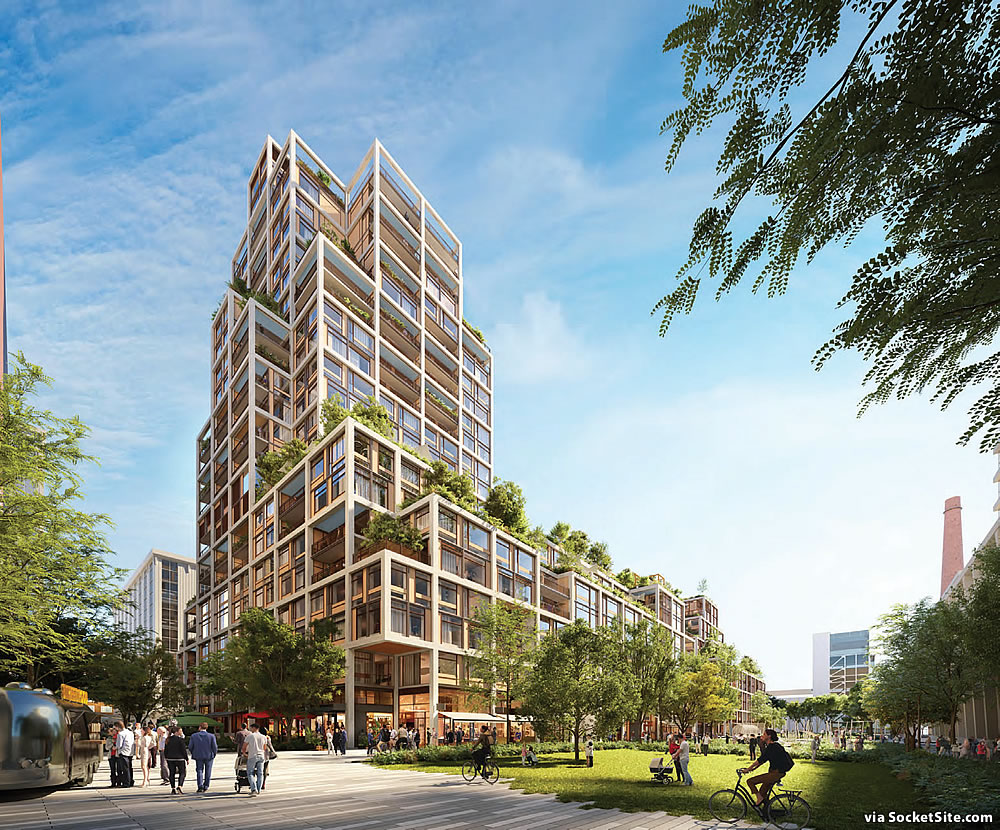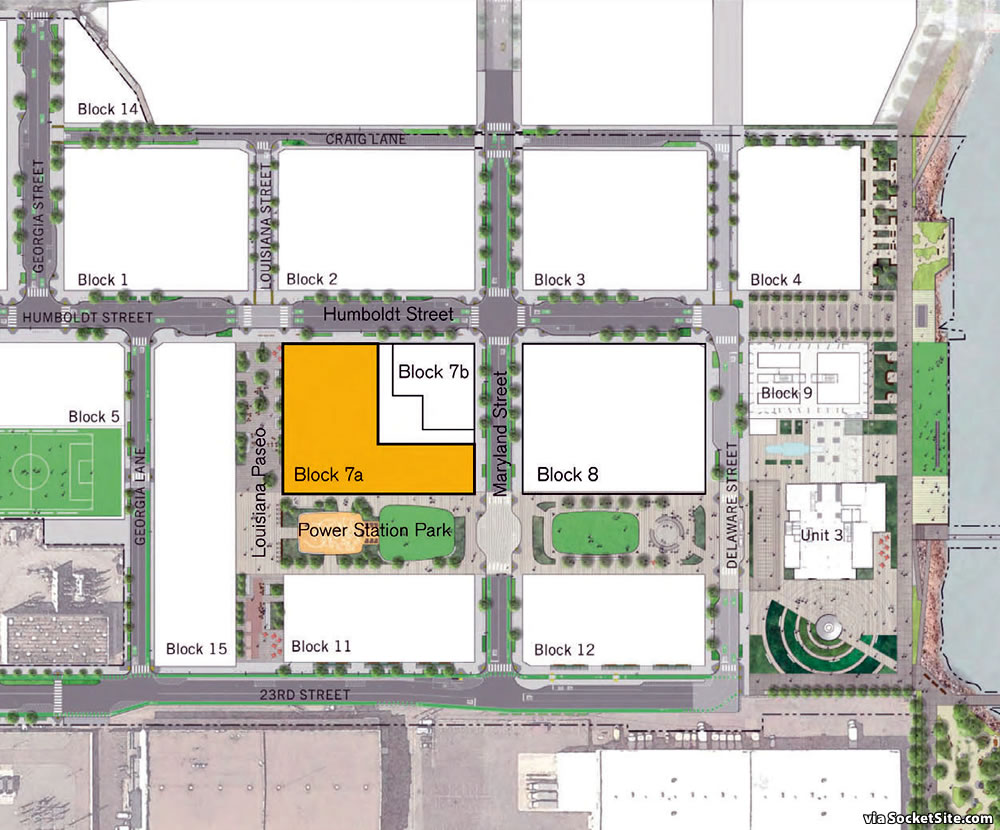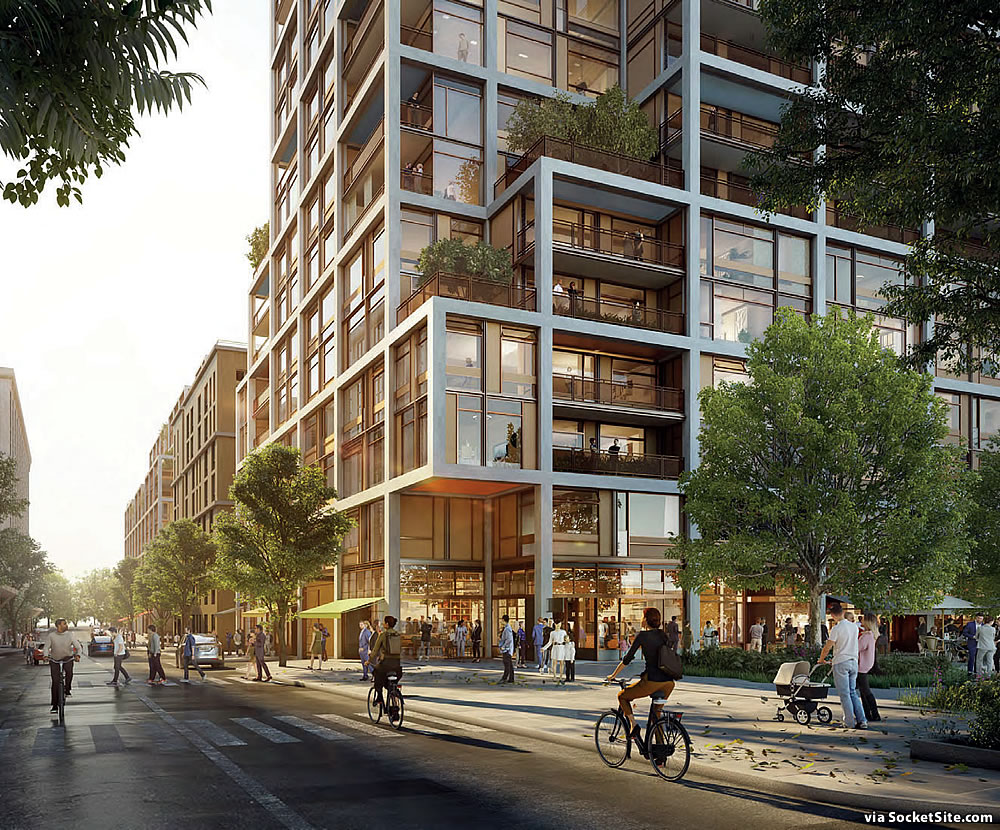As designed and since refined by Foster + Partners and Adamson Associates, the proposed 27-story tower to rise up to 237 feet in height upon Block 7A of the Potrero Power Station site, along Humboldt Street at the intersection of the future Louisiana Paseo/Street, will yield 325 residential units, with 9,950 square feet of ground floor retail space, a 6,000-square-foot child care center, and a basement garage for 153 cars.
The tower’s 85-foot-tall podium will front the future Potrero Station Park, stretching to Maryland Street. And in addition to over 10,000 square feet of shared open space, 110 of the block 7A units will have private balconies or terraces.
And with construction on the tower slated to commence in 2023, the refined designs for the development, which can be administratively approved, will be presented, informationally, to San Francisco’s Planning Commission this week.



If both Mission Rock and Potrero Power hit their deadlines, in 2035 the Mission Bay / Dogpatch area will be completely revitalized. By then, additional businesses will have already sprouted up around Chase Center, more Mission Bay apartments will have been infilled, Bay Front Park will be done, and the ferry will be active.
People hate on SF for not changing enough, but an entirely new neighborhood including a hospital complex, sports arena and a huge amount of housing/office/parks being completed in ~35 years is pretty cool. Let’s relish the wins a bit more.
I couldn’t agree more. Mission Bay is already a gigantic win.
Ah yes – the empty retail storefronts, the sinking streets pulling sidewalks away from buildings – the bland impersonal architecture. Every time I’m there I scratch my head wondering what all the fuss is about … After all, any city can build a bland suburban office park…
I don’t see it as bland impersonal architecture but it seems you do. Everyone has different tastes. What you like someone else won’t. Some people like Victorians and some people like Contemporary. When it gets messed up is when you take a Victorian and try to turn it into a Contemporary.
LOL. You sound like me. I agree that, aside from some efforts at landscaping, Mission Bay is effectively a bland suburban office park, That said, Mission Rock will have at least one interesting contemporary structure – the “earthquake” condo tower.
Your underlying argument here is that if it doesn’t adhere to your subjective aesthetic tastes or hasn’t already evolved a mature neighborhood identity when it’s still extremely new and not even completed, then it’s inherently bad. And just to be clear, this is a totally absurd “standard” to hold anything to. Don’t like it? Then don’t go there. Simple as that. Don’t pretend like it isn’t valid or that it’s unwelcome.
“Don’t like it, don’t go there”. It seems a lot of people are following that advice.
There’s a reason some neighborhoods are successful and others aren’t. You can get defensive and claim it’s my personal subjective tastes, but the fact is that people prefer neighborhoods where buildings stop at a certain height (taller does not always equal better), and retail spaces that are narrow and deep instead of shallow and broad. Modern planning codes push the latter, so we wind up with there being 3 or 4 retail shops on a block, instead of 10 or 12 – and having fewer retail options means less variety and less impetus for people to go out and explore.
Look around the world. Yes there are some popular skyscraper-heavy areas, but then every rule has exceptions. Time and again people flock to neighborhoods with small blocks, multiple storefronts per block, and building heights of 5 to 7 stories max. Central Paris is more popular (and by that I mean to residents, not tourists) than La Defense… Kensington and Hyde Park, Hells Kitchen and the Village … even here in S.F., Chestnut or Cow Hollow or Hayes Valley are immensely popular. (And the latter provides a good counterpoint to analyzing Mission Bay; until the freeway overpass across Market Street and thru Hayes Valley was torn down, H.V. was pretty dumpy … so its commercial renaissance history dates back not much longer than Mission Bay, yet it is immensely busier and more popular.)
I’m hard-pressed to think of any “new” neighborhood like Mission Bay that is as popular as it’s older counterparts – people in DC don’t go to Crystal City to hang out; it’s vice versa – the Seaport District in Boston is full of Mission Bay-style offices and hotels, but its foot traffic and overall appeal still pales compared to … well, just about any other neighborhood in Boston. Etc.
Believe it or not, it’s possible to criticize something and have it be based on objective observation and not just my supposed personal whaa whaa that I don’t like modern architecture. (And in fact, if we had interesting and world-class architecture in Mission Bay it might be a different story altogether. The NY High Line redevelopments are a good example of that. But what’s been put up in Mission Bay is far from that level of distinction.)
“the fact is that people prefer neighborhoods where buildings stop at a certain height”
This is not a fact. This is also completely based on personal, subjective preference.
Aside from all of this, you’ve just totally chosen to ignore again that the neighborhood is very new, not even completely built out to plan, and (as with ALL neighborhoods) needs time to evolve its own feel and identity. Nothing you (or I for that matter) say is going to affect anything. Beyond that, I don’t know what to tell you — you’re obviously convinced that the area is a failure with little to no chance of becoming whatever you consider to be successful.
Please tell me about all the walking you used to do on Illinois or Terry Francois? Or all the times you enjoyed paddle boarding the Bay at Crane Cove Park? Or all of the small businesses you used to support that developers have brought in to the neighborhood? Housing, hyper local living, supporting economic vitality in underutilized and remediated zones, and improved public transit it what the fuss is all about. Myopathy much…
I will give you that the Chase Center was granted too much underutilized surface area and that will continue to be a barrier to further immediate activation.
“hyper local living, supporting economic vitality in underutilized and remediated zones”.. well at least you’ve got down the latest iteration of cool planner-speak… Hyper local living? Ah yes, all those vegetable farms in Mission Bay. Economic vitality – well, that’s exactly what we’re debating here. When I’m there I don’t see a lot of it. Improved public transit – well, that’s exactly the thrust of this comments section, and I think there needs to be a lot *more* of it (and I think that the bit that’s been done over the last 10 or 20 years is quite underwhelming).
Hackneyed take which is sooooo 2012.
“I’m hard-pressed to think of any “new” neighborhood like Mission Bay that is as popular as it’s older counterparts – people in DC don’t go to Crystal City to hang out”
Crystal City is in VA not DC. And DC is the exact example of a place where “new” neighborhoods have had success, i.e. NOMA, Atlas, Navy Yard, Columbia Heights, Logan Circle, Chinatown, Bloomingdale, and Shaw are all successful neighborhoods that have been redeveloped or created since 2000.
Have you seen the Toronto skyline for the entire city change in just 5-6 years? It’s night and day.
Waiting 14 more years to see change is just pathetic.
I don’t follow Toronto’s skyline closely, but I’ve seen San Francisco’s skyline change quite a bit in the last 5-6 years as well, including the Salesforce Tower and numerous other 20-60 story buildings in the Central SOMA / South Beach / Transbay area.
My point is that San Francisco is not preserved in amber as some claim. There is noticeable change in the eastern half of the city.
Toronto? You’re using Toronto as an example of what San Francisco needs to catch up to? Rapid growth and a quickly changing skyline means nothing. Toronto will never have the charm of a world class city like San Francisco. The only reason for the rapid slapping up of new condominiums is for exploitative reasons. With a city that is actually beloved by its citizens, things take time to make sure it’s done right and for the right reasons.
Totally nonsensical to pretend Toronto isn’t beloved by a lot of its citizens. It also has really nice historical streetcar suburbs, something SF will never have, and most of which did exist in the Bay Area have been destroyed and replaced with car-centric sprawling detached single family suburbs.
Nice historical streetcar suburbs… like the Richmond district?
I think of Toronto as a world-class city, and we’d be so lucky as to have half the effort at public transit improvements (and local government consolidations / de-balkanization).
The only negative of Toronto in my mind is the weather, but that has nothing to do with the question at hand about successful redevelopment (and is in any event subjective, as evidenced by the population of Toronto which is several times that of San Francisco).
I would respond with, be careful what you wish for. How many people do you want to cram onto the end of a peninsula? Not every city needs constant growth, not everyone gets to live in San Francisco, just because they desire to. Do you want to experience a city that feels more like Paris or Toronto? Let’s not ruin everything.
or Vancouver, or Seattle, or even our boogeyman Los Angeles.
And in the meantime, virtually no additional public transit infrastructure to meet this massive increase in density – yes, some minor (emphasis minor) improvements vis-a-vis the Chase Center, but that is a drop in the bucket for the increased demands these neighborhoods will generate. We should be doing a new underground line *now* to service these areas in the future.
You mean the Central Subway, scheduled to open in six months?
After how many years (and years and years) to build a couple miles? You realize that in a couple decades L.A. has built an entire multi-line subway and light rail system, stretching from Santa Monica to east of Pasadena and from North Hollywood to Long Beach? And you’re trying to trumpet the Central Subway (*which doesn’t even proceed to North Beach, even though they dug that far*) as an example of San Francisco success?!
“scheduled to open in six months”
and btw, it’s been “scheduled to open in six months” for about 3 years now… after breaking ground in 2010. That’s a whiz-bang public works project, yes indeedy.
They built a new underground subway to support growth and timed the opening dates nearly perfectly. They are adding a ferry as well. They merged two redundant light stations into one larger, centralized one. MUNI and Chase Center have a partnership where a ticket to an event means free MUNI. They designed the streets for easy Uber / Lyft drop-off flow. They re-designed bus lines. They rehabbed the Third Street pedestrian bridge.
That’s a fairly comprehensive rollout plan.
“timed the opening dates nearly perfectly”?!?! You realize this project is years over schedule and hundreds of millions of dollars over the original budget, right? There’s nothing “planned” about the currently targeted opening date for the Central Subway (which I won’t be a bit surprised if it slips *yet again*).
Note I’m not one of the people saying the Central Subway is an outright boondoggle that shouldn’t have been built. I’d like to see a lot *more* undergrounding of existing and new Muni lines. But to point to the Central Subway as an example of success and achievement is truly laughable.
What the hell is your alternative if you claim the Central Subway should never have been built in the first place? With that position, you’re quite literally advocating for worse transit for the area, which totally contradicts your claim to want the area better connected to transit.
At what point did I say it “should never have been built”? In fact, I specifically said “I’m NOT one of the people saying the Central Subway […] shouldn’t have been built”. (emphasis added)
So if you want to put words in my mouth, how about “it should have been built within the budget and timeline first proposed” — in which case it would’ve been operational for several years by now. And hence no, I’m not “quite literally advocating for worse transit for the area”; in fact, quite the opposite.
As we outlined a few years ago (and shouldn’t catch any plugged-in readers by surprise): Planning for the Population Doubling and Public Realm of Dogpatch.
Ah yes, 3 years ago a report came out that was 4 years in the making … the gist of which vis-a-vis public transit was some “focus points”. Not new lines, not a new underground… “focus points”.
Agreed. San Francisco has not been structurally readied for any of its 21st century needs, rather its just being infilled to death with the same trademark SF approach to planning that brought us the ugly boxes stacked on Twin Peaks, the hulking filthy Fillmore Center, the cheap crumbling faux stucco of the Filipino Historical district, etc.
The Fillmore Center, hate it or not, is one of the cleanest, best maintained properties in the City. Maybe the insides are, as you say, “filthy”, but the public spaces are immaculate.
I hope they don’t ‘Value Engineer’ this one too badly.
I’m surprised the Dogpatch has been untapped for so long. The neighborhood gets the best SF weather in my opinion. Good to see things shaping together for the Dogpatch/Mission Bay Area!
I saw Dogpatch’s potential a quarter-century ago when I moved into one of the first loft conversions (701 Minnesota). I live in a different part of town now and am delighted to see Dogpatch blossom. Curious about the folks I see who insert “The” in front of Dogpatch, though. It was always just “Dogpatch” for as long as I remember. Maybe these folks are migrants from LA, where they put “The” in front of highway numbers, too. Hint: doing that here is a giveaway. It’s just 101, please.